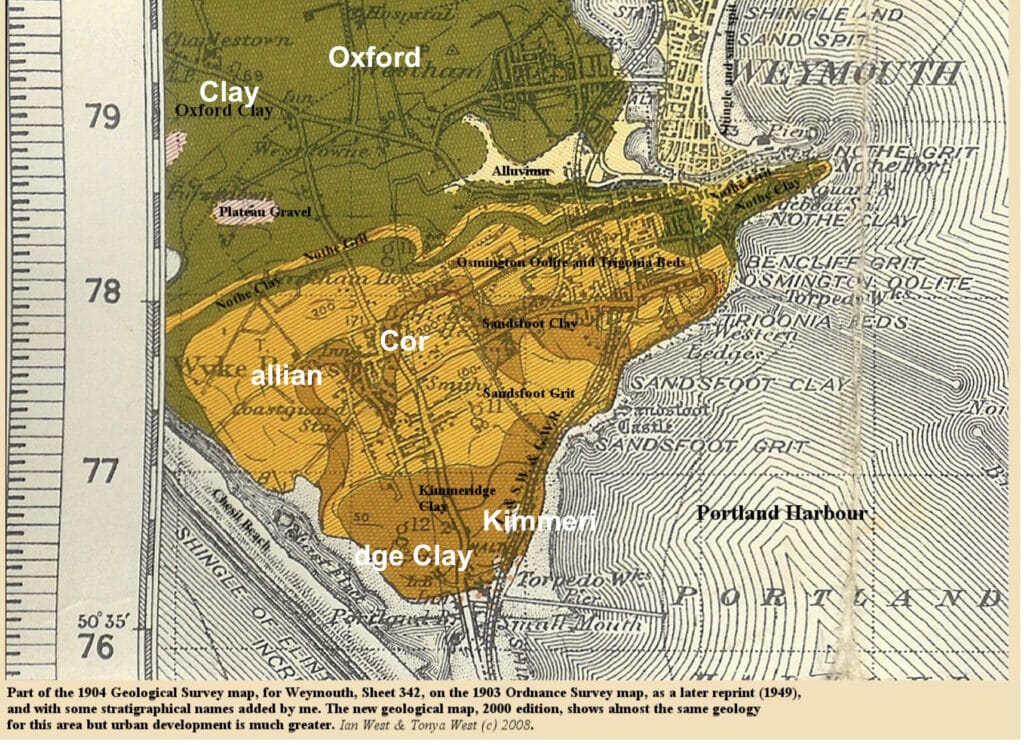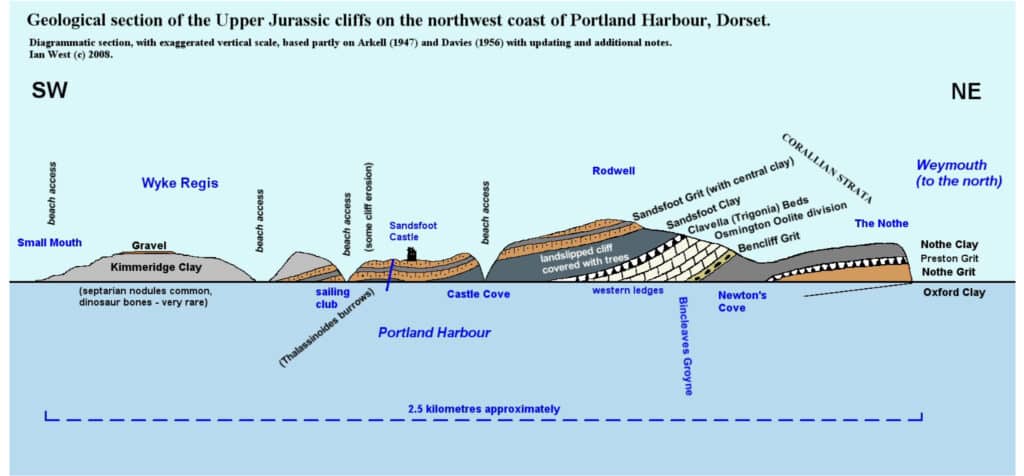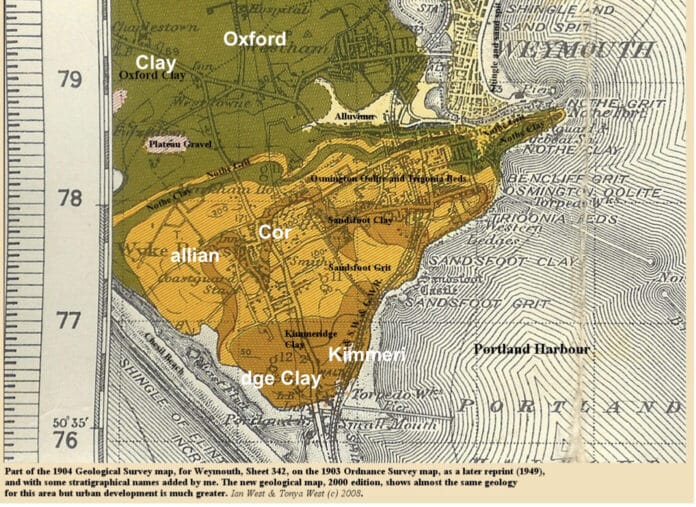This walk is best attempted when there is a low tide, especially a low spring tide (which occur around midday when there is a full moon and new moon).Slippery rocks also occur in places especially round the foot of Sandsfoot Castle so care should be taken.
The coastal section is on the southern side of a geological fold structure called the Weymouth Anticline (a dome shaped fold) and the rock layers (strata) dip gently to the south (out into the harbour). All the rocks seen are from the Upper Jurassic formed in marine conditions around 155 million years ago when what we now call Dorset was at a latitude of around 30oN (Mediterranean and Caribbean conditions).
Start by making your way to the beach in Old Castle Road via the Sandsfoot Beach steps (the former site of Sandsfoot Castle Sailing Club). Walk along the shore to the left (east) until you approach the Portland Harbour breakwaters.
On the way you will notice remains of trees which have come down in landslips in recent years. Mass movement like this occurs in the cliffs above the beach because of the inter-layered permeable (limestone or sandstone) and impermeable rocks (clay). In places you will notice water seeping to the surface where a permeable layer rests on an impermeable layer. Water and gravity cause the landslip events to occur. Looking at the cross-section below you will see Sandsfoot Clay rests on the Clavellata Formation (a limestone). The clay absorbs water, loses strength and slumps down slope taking everything with it. This is why the former Under Barn walk has been closed for many years and cliff top properties are at risk.
The harbour breakwaters were constructed of Portland Roach, the top shelly bed of the Portland stone. They were planned in 1844 to shelter ships of increasing size and to form a strong naval base as a defence against France. By 1855 major progress was being made and 560 men were employed on the breakwater. Stone from the Admiralty quarries on Tophill, worked by convict labour, was deposited at the rate of 10,000 tons per week. The first stage was complete by 1867. There were forts at each end of the two initial sections and at the Nothe (Weymouth). A new section was built from the north side between 1895 and 1903 by civil engineering contractors. Later, in an attempt to prevent submarine incursions the old battleship HMS Hood was sunk in the South Ship Channel. Admiralty Quarry is now at the end of its commercial life and plans are in place to retain exposures in the quarry faces in the proposed Portland Quarry Park.
Succession of rocks seen from Weymouth Harbour to Ferrybridge.

Geological map of the area derived from http://www.southampton.ac.uk/~imw/Portland-Harbour.htm

Geological cross-section derived from
http://www.southampton.ac.uk/~imw/Portland-Harbour.htm

Just below Portland House the cliffs are quite stable because of the limestone beds that form the cliff (Clavellata or Trigonia Beds and the Osmington Oolite seen in the diagram above). These beds are quite fossiliferous and the fossilscan easily be seen in the ledges on the beach. Myophorella (Trigonia) clavellata in an ‘oyster’ or bivalve having a thick shell with rows of nodules on the surface. Unfortunately the rock in which they are preserved is as hard as the shells so they are rarely found loose on the beach. Sometimes the shell surface is seen and sometimes sections through the shells.
Another common feature on the beach are blocks of rocks with what are called trace fossils, not actual fossils but where organisms have been making burrows or tracks when the rocks were wet sand and mud on the sea floor. The Jurassic sea floor was often very rich in life having warm shallow water with plenty of light and oxygen and lots of food. Creatures such as worms and shrimps burrowed through the sea floor sediment looking for food. Snails (gastropods) also crawled over the sea floor. Some of the rocks on the beach are very shelly, again showing how rich the Jurassic sea floor environment was. Careful searching with a magnifying glass or hand lens can often reveal even more fossil ‘treasures’.
Apart from Myophorella the occasional ammonite can be found and also belemnites (squid like creatures) that have a bullet like shell (guard) which helped to give them a streamlined shape.
At Sandsfoot Beach evidence can be seen of attempts to protect property on Old Castle Road by using large blocks of Portland Stone – rock armour – to hold the cliff in place which has been successful in the short to medium term. However there is a risk in the long term even possibly cutting Old Castle Road.
Moving on to Sandsfoot Castle, currently conservation work is being carried out on the Castle. It was built at the time of Henry VIII and has been undermined over the years causing some collapse hence the large blocks of masonry on the beach. The stone used was mostly Portland Stone but some more local stone was used for the foundations orange yellow sandstone (Sandsfoot Grit) and limestone, some of which is quite fossiliferous. Some boulders were used in the foundations and these probably came from the beach and were shaped when the harbour was open to the sea before the breakwaters were built.
The bay just west of the Castle has some fossiliferous Sandsfoot Clay and large flat oysters (Ostrea delta) can easily be collected. These may look modern but ar 155 million years old. Trace fossils are also common in the Sandsfoot Grit.
Beyond this bay further attempts have been made to protect property and the geology is obscured.
The next exposures are further west beyond the Sandfoot Sailing Club when the Kimmeridge Clay occurs. This is not well exposed as the clay forms low slumped cliffs (which are often vegetated) and former coastal defences can be seen decaying along the beach. However careful searching, especially in winter / spring after some wave action, fish teeth, occasional marine reptile vertebrae and bivalves can be found.
If you reach Ferrybridge you can return via the Rodwell Trail to your starting point.
Join us in helping to bring reality and decency back by SUBSCRIBING to our Youtube channel: https://www.youtube.com/channel/UCQ1Ll1ylCg8U19AhNl-NoTg SUPPORTING US where you can: Award Winning Independent Citizen Media Needs Your Help. PLEASE SUPPORT US FOR JUST £2 A MONTH https://dorseteye.com/donate/







